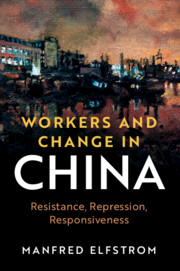Book contents
- Workers and Change in China
- Cambridge Studies in Contentious Politics
- Workers and Change in China
- Copyright page
- Dedication
- Contents
- Figures
- Maps
- Tables
- Acknowledgments
- 1 Introduction
- 2 Recipes for Resistance
- 3 Bureaucratic Incentives
- 4 Orthodox Control
- 5 Risk-Taking Control
- 6 Increased Repressive and Responsive Capacity
- 7 Bottom-Up versus Top-Down Change
- 8 Conclusion
- Appendices
- References
- Index
- Series page
2 - Recipes for Resistance
Published online by Cambridge University Press: 14 January 2021
- Workers and Change in China
- Cambridge Studies in Contentious Politics
- Workers and Change in China
- Copyright page
- Dedication
- Contents
- Figures
- Maps
- Tables
- Acknowledgments
- 1 Introduction
- 2 Recipes for Resistance
- 3 Bureaucratic Incentives
- 4 Orthodox Control
- 5 Risk-Taking Control
- 6 Increased Repressive and Responsive Capacity
- 7 Bottom-Up versus Top-Down Change
- 8 Conclusion
- Appendices
- References
- Index
- Series page
Summary
Before we can examine the consequences of China’s rising worker resistance, we must explore the recipes for resistance that drive it. Why and how Chinese labor mobilizes have already been the focus of a rich body of literature. In this chapter, I will first very briefly summarize the key characteristics of Chinese industrial relations and then review the scholarship that has been conducted to date, emphasizing how perspectives on workers in China have changed over time, from pessimism to guarded optimism and back again, while highlighting certain key themes in the research, such as extreme exploitation, workplace arrangements that facilitate and frustrate organizing, the unique constraints and opportunities of migrant workers, and concerns over informal and flexible work. Then, I will introduce a fresh typology of different forms of activism distinguished by the varying level of pressure that they bring to bear on the state. Specifically, I will identify certain combinations of demands, tactics, and organizations as contained, boundary-spanning, or transgressive. Next, I will provide evidence that boundary-spanning and transgressive mobilization are on the rise. Strikes, protests, and riots are increasing more quickly than formally adjudicated employment disputes; workers are claiming more than the bare minimum of what Chinese law guarantees them, and new organizations, such as movement-oriented labor NGOs and leftist student networks, are entering the fray.
Information
- Type
- Chapter
- Information
- Workers and Change in ChinaResistance, Repression, Responsiveness, pp. 21 - 45Publisher: Cambridge University PressPrint publication year: 2021
